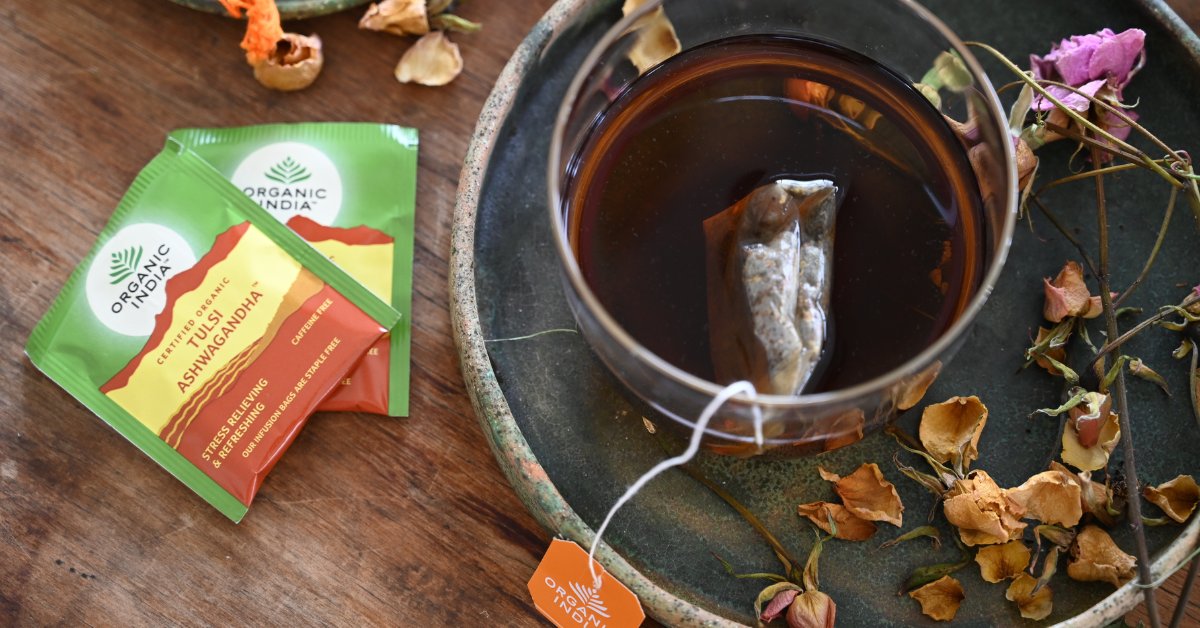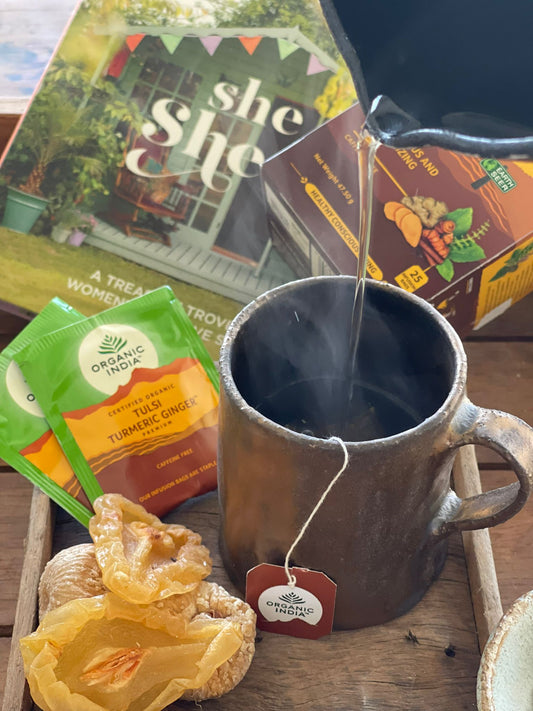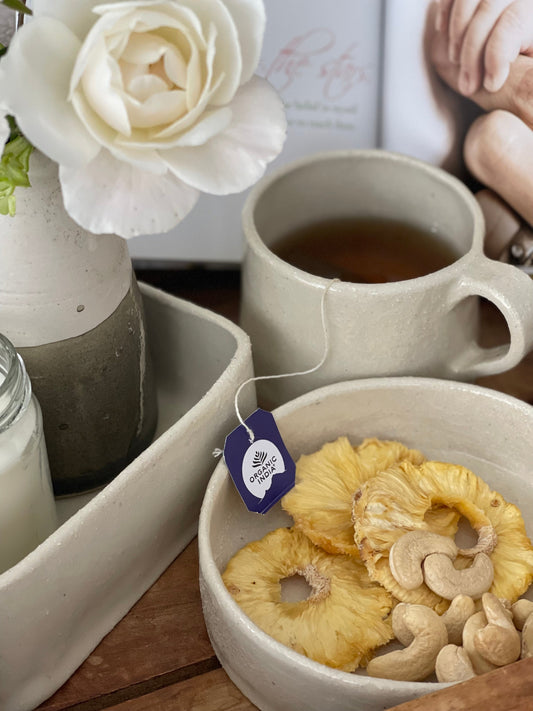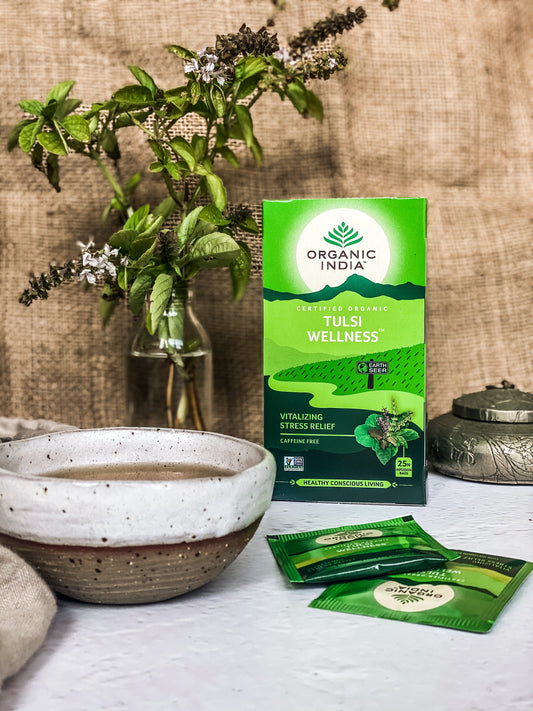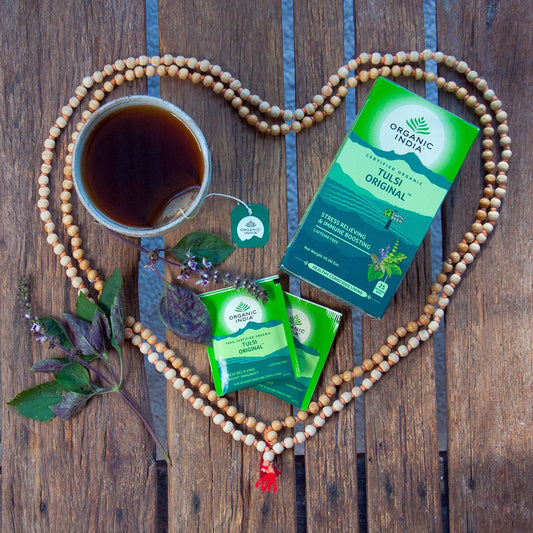How do you make the perfect cup of Tulsi Tea? There are several factors that will determine your choice of tea, the tea making method and most importantly, the taste! To make a delicious cuppa, read on…..
Caffeinated Tea or Herbal Infusion?
First up, how we make a cup of tea will depend on which sort of tea we are making. Is it a variation of caffeinated black tea, white tea or green tea, or is it a herbal infusion, free from caffeine? The type of tea will inform steeping time and water temperature.
True ‘tea’ is made from the leaves and buds of Camellia sinensis; they are used to make black teas, oolong teas, white teas and green teas – all containing caffeine.
A herbal infusion or tisane, is commonly referred to as a ‘herbal tea’ despite not containing the tea plant. It is made from flowers, leaves, pods or roots of plants such as Tulsi leaves, Ginger root, Rose petals, Chamomile flowers, Licorice root, Cardamom pods, or Peppermint leaves, to name just a few examples! It is caffeine-free.
Loose or Teabag?
The next factor is whether you are using loose leaves or a teabag.
If using loose leaves you will want to have a convenient way of infusing or steeping them so that they can be removed after a certain amount of time to achieve the desired flavour and to impart their nutritional properties. You could use the traditional teapot and strainer, a tea flask with a removable diffuser basket, a diffuser ball that sits inside your cup, a coffee plunger, a reusable teabag, or in the case of some teas like Chai, you could bring to the boil on the stove.
Teabags offer the convenience of being able to be added straight to your cup; so just choose your favourite tea cup, whether it be a traditional fine-boned china teacup and saucer, or a bowl-sized mug!
Filtered Water
Your cup of tea will be approximately 98% water, so the quality of the water you use is really important! The quality of our tap water may vary, sometimes tasting hard or chlorinated, which will affect the taste of your tea.
Purified water comes from spring water that is filtered through underground rocks. Well water is also a form of purified water. Purified water is considered the most natural form of water, and therefore gives the best taste to your cup of tea. Not all of us are lucky enough to be able to access this; but you may have filtered water available.
Filtered water has been passed through a filtration system to remove any metals and other contaminants. This is another wonderful option for a delicious cup of tea.
Steeping Time
Steeping time can significantly influence the taste of your tea.
The basic rule of thumb is:
Black tea: 3 -5 minutes
Green tea: 3 minutes
Herbal tea: Usually at least 10 minutes
Herbal teas need longer steeping time than black or green tea to ensure the flavour, phytonutrients and other beneficial properties are diffused into your water. Some herbs do better with longer steep times, and some of us prefer a richer flavour so tend to infuse them longer, up to an hour even.
It is always best to look for the steeping instructions on your tea packaging to ensure that you are getting the most from your herbs. Good quality herbs can usually be steeped twice.
Boil your water once only ideally, to maintain the water’s oxygen; multiple boiling of the same water can reduce the oxygen content of the water.
Steep it Covered
Whether you are steeping loose tea or a teabag, make sure you cover your vessel to ensure you don’t lose any of the goodness from your herbs. For example, Tulsi leaves contain oils including Eugenol which has been shown to have anti-inflammatory, antibacterial and antioxidant actions. The Eugenol is extracted from the Tulsi leaves via the steam, so you don’t want to let all that goodness escape during the infusing time.
If you’re steeping in a cup without a lid, just pop a small saucer or dish over the top for the duration of the recommended steeping time.
To make the perfect cup of Tulsi Tea:
Step 1: Boil water in the kettle, to a rolling boil.
Step 2: Choose your equipment!
Step 3: Steep 1 tablespoon of loose Tulsi OR 1 teabag per cup for 5 – 10 minutes (or longer!). Cover your vessel whilst steeping to ensure you don’t lose any of the goodness of the Tulsi leaf oils.
Step 4: Remove the lid and the teabag or Tulsi leaves (or strain), and allow to cool to drinking temperature.
Step 5: Sip while savouring the clean, aromatic, energising tea. Notice the hints of lemon and citrus from Vana Tulsi, the slightly spicy tones of Krishna Tulsi and the calm depth of Rama Tulsi.
Step 6: Feel good in the knowledge that every cup of Tulsi tea supports the livelihood of over 2000 rural family farmers in India, as well as the wellbeing of the planet.
Step 7: Also feel good because you can re-steep, or empty your leaves into the compost – a sustainable practice 😁
